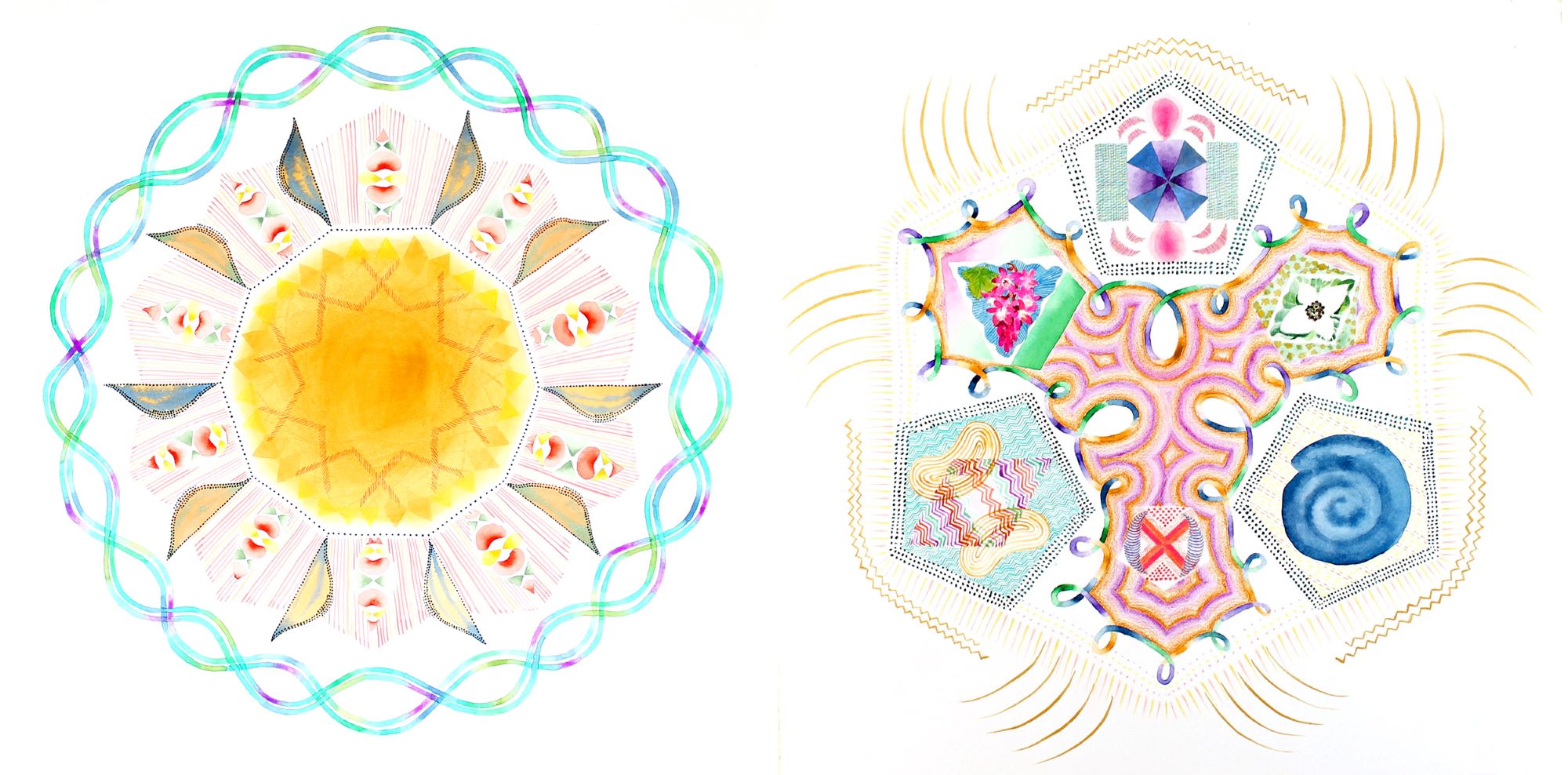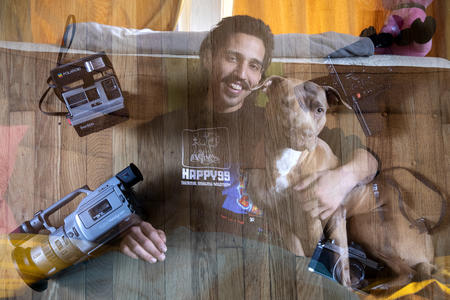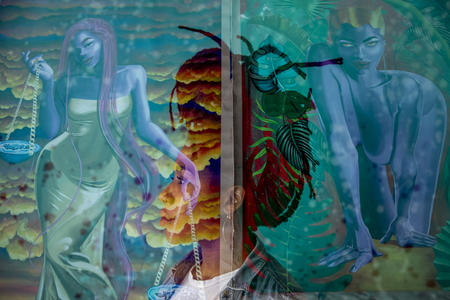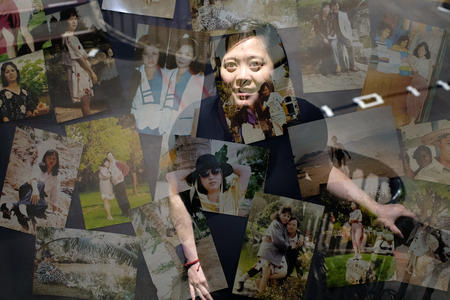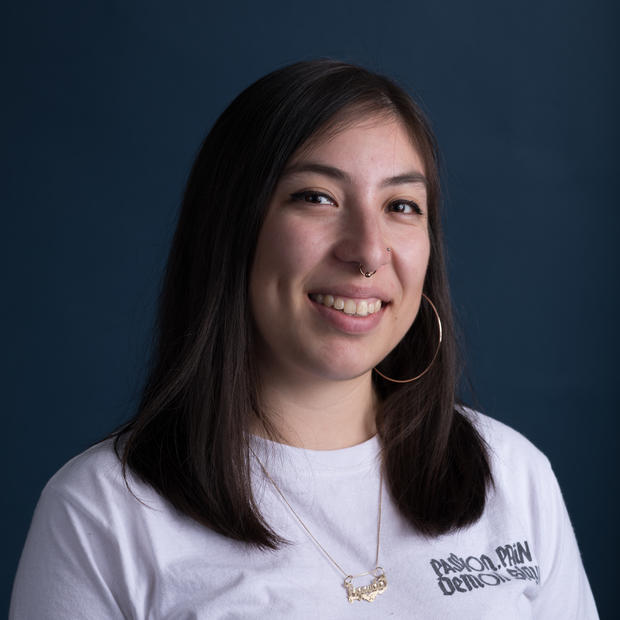First, she gets a sense of the client, either in person or by examining a photo. Then, she asks a team of spirit guides a set of yes or no questions regarding every detail of her painting. She begins at the center and moves outward, adding shapes and color to create a geometric, pastel mandala. Along the way, her “soul team” responds via “energy testing,” which involves Nguyen forming an “O” with her index finger and thumb. If she can’t break through the O with two fingers of her other hand, the team is signaling that the design element is an accurate reflection. The process takes about 20 hours per soul.
Since 2014, in tandem with her spirit team, Nguyen has created more than 65 soul portraits using watercolor, colored pencil and gouache. The delicate kaleidoscopic designs sometimes look like a molecular structure, sometimes an otherworldly flower. Their botanical appearance is rooted in Nguyen's childhood.
“I love plants,” she says, sitting in her home studio, where the windows are lined with succulents. She notes that growing up her mother owned a nursery, where she used to help out. “I was my mom's right hand,” she recalls.
Nguyen’s knowledge of horticulture helped pay the bills during college. After graduating with a Bachelor of Arts from the University of Washington in 1999 she moved to New York City, where she worked in a high-end garden shop. In 2003, she returned to her hometown on Whidbey Island. Today Nguyen is back in Seattle, where her day job is at the Mockingbird Society, a nonprofit advocacy organization for youth in foster care. She continues to make art to stay connected to the healing power of “spirit.”
This week, she makes her debut as an art curator with the show Conscious Collaboration with Spirit at Pioneer Square’s SOIL Gallery. Featured is work by seven local and national artists (including Nguyen) that reflect the wide spectrum of work that can result from letting spirits guide your paintbrush.
This interview has been edited for length.
When did you bring spirituality into your practice and where did that desire come from?
When I lived in New York, I saw the division in society so starkly — in a way that I hadn't before because I grew up in a pretty protected, sheltered community on Whidbey Island, [which is] predominantly white. In New York it was the ultra-wealthy [with] the homeless sleeping on the street right outside their door. I was working at a really high-end store and I was like, “I don't want to be selling luxury to rich people. I don't want to be part of this system, I need to somehow take my energy and find a way to change the system instead of contributing to the system.” That's when I started studying healing stuff and social justice.
What did you notice when you started consciously collaborating with your soul?
I was doing my master's in social work at the time [at Washington University in St. Louis]. So I really needed something that connected me to my art self. I'd spend 20 to 40 minutes each night doing a drawing, but in looking at them I felt I'd over-decorated or aestheticized things. I already know how to talk to my soul through energy testing, so I was like, “Maybe I should just ask my soul what to paint.” I started asking my soul and the difference was so marked; right away I was hooked.
Can you tell when other artists are in touch with their souls?
What I see in artwork where people are connecting to their soul — [or] their higher self, a kind of deeper truth, people will call it different things — [is that] those pieces are surprising and actually bring something new to the world versus looking like something you've seen before.
How come your paintings are so geometric?
I love pattern and color and geometry, so that's the lens that I project the truth through. They end up being readings as well, like, information that's really particular to that soul comes through. And none of the soul pattern portraits look alike, even though they're all geometric. There's been weird little esoteric bits of information that come through in them sometimes. Like one time I was asked [by a spirit guide] to use cigar ash [in a painting].
Why ash?
Her dad — he was Cuban — smoked cigars. And she used to eat his cigar ashes when she was like 2 ½. So it was a point of connection between them. I think that it was basically a message from her dad for her soul. It was supposed to be rubbed right at the center of her soul pattern portrait. So it made this gray hazy center.
Who or what does your team of soul guides consist of?
There's two groups of beings that are on my soul team. One is a group of beings that are beings of nature. So the Deva [a nature spirit, from ancient Indian literature] of healing is on my team, the Deva of sacred geometry and the Deva of color and pattern. There's also human souls — my soul, the person's soul that I'm working with and two human soul collaborators that I don't think are in physical bodies or on the Earth’s plane.
Your work requires a leap of faith that some people may not be able to believe. What do you say to those people?
I think whether people believe in it or not, they usually find the patterns nice to look at. The pieces are beautiful and interesting. Ellen Ito [one of the curators at Bellevue’s Bellwether arts festival, which featured Nguyen’s artwork in 2019] said people felt calmed by my piece and that they gravitated towards it. I think that that speaks to the truth there.
What if you encounter bad energy from someone’s soul? Have you ever?
That’s a question I get a lot. No. While humans struggle and have all kinds of moral dilemmas and make some bad choices, our souls are good. Our souls are in it for love and for learning and are trying to help us. We may not navigate with grace the whole time and we may get stuck in things that are really damaging and harmful. But our souls are basically always good.
What do people misunderstand about being an artist in Seattle?
That’s not for me to judge, but I think in general people get caught up in what they think is going to sell. I think our ego and conscious mind make choices that are safe and based on what [artists] think has succeeded already. Because [artists] want attention, they're trying to line it up with what's actually going to work in the world. It's tough. It's hard if you're not playing the game to actually get noticed. But I think that that ends up making work that is boring a lot of the time. I want to see people make work that's just truly their own.
What’s the most pressing issue facing local artists?
Seattle has undergone a lot of changes related to tech jobs, and housing prices are through the roof. Rising real estate prices basically push people out of their studios and living situations, and galleries are not able to make enough money to stay open. There's been a shrinking of possibilities, but artists are super creative. I mean, we know some artists with a show in their [refrigerator] freezer called Seattle Freezer. People make space. That tells me that artists are resilient enough and will continue to find a way.
